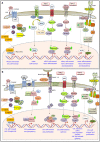Common stemness regulators of embryonic and cancer stem cells
- PMID: 26516408
- PMCID: PMC4620423
- DOI: 10.4252/wjsc.v7.i9.1150
Common stemness regulators of embryonic and cancer stem cells
Abstract
Pluripotency of embryonic stem cells (ESCs) and induced pluripotent stem cells is regulated by a well characterized gene transcription circuitry. The circuitry is assembled by ESC specific transcription factors, signal transducing molecules and epigenetic regulators. Growing understanding of stem-like cells, albeit of more complex phenotypes, present in tumors (cancer stem cells), provides a common conceptual and research framework for basic and applied stem cell biology. In this review, we highlight current results on biomarkers, gene signatures, signaling pathways and epigenetic regulators that are common in embryonic and cancer stem cells. We discuss their role in determining the cell phenotype and finally, their potential use to design next generation biological and pharmaceutical approaches for regenerative medicine and cancer therapies.
Keywords: Cancer stem cells; Embryonic stem cells; Pluripotency; Self-renewal; Tumorigenicity.
Figures

References
-
- Evans MJ, Kaufman MH. Establishment in culture of pluripotential cells from mouse embryos. Nature. 1981;292:154–156. - PubMed
-
- Thomson JA, Itskovitz-Eldor J, Shapiro SS, Waknitz MA, Swiergiel JJ, Marshall VS, Jones JM. Embryonic stem cell lines derived from human blastocysts. Science. 1998;282:1145–1147. - PubMed
-
- Tesar PJ, Chenoweth JG, Brook FA, Davies TJ, Evans EP, Mack DL, Gardner RL, McKay RD. New cell lines from mouse epiblast share defining features with human embryonic stem cells. Nature. 2007;448:196–199. - PubMed
Publication types
LinkOut - more resources
Full Text Sources
Other Literature Sources

